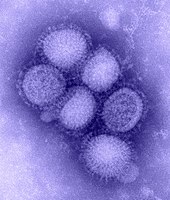
Photo from wikipedia
SUMMARY An outbreak of influenza A(H1N1)pdm09 was detected during the ongoing community-based surveillance of influenza-like illness (ILI). Among reported 119 influenza A(H1N1)pdm09 cases (59 cases in the year 2012 and… Click to show full abstract
SUMMARY An outbreak of influenza A(H1N1)pdm09 was detected during the ongoing community-based surveillance of influenza-like illness (ILI). Among reported 119 influenza A(H1N1)pdm09 cases (59 cases in the year 2012 and 60 cases in 2015) in summer months, common clinical features were fever (100%), cough (90·7%), sore throat (85·7%), nasal discharge (48·7%), headache (55·5%), fatigue (18·5%), breathlessness (3·4%), and ear discharge (1·7%). Rise in ILI cases were negatively correlated with the seasonal factors such as relative humidity (Karl Pearson's correlation coefficient, i.e. r = −0·71 in the year 2012 and r = −0·44 in the year 2015), while rise in ILI cases were positively correlated with the temperature difference (r = 0·44 in the year 2012 and r = 0·77 in the year 2015). The effective reproduction number R, was estimated to be 1·30 in 2012 and 1·64 in 2015. The study highlights the rise in unusual influenza activity in summer month with high attack rate of ILI among children aged ⩽9 years. Children in this age group may need special attention for influenza vaccination. Influenza A(H1N1)pdm09 outbreak was confirmed in inter-seasonal months during the surveillance of ILI in Pune, India, 2012–2015.
Journal Title: Epidemiology and Infection
Year Published: 2017
Link to full text (if available)
Share on Social Media: Sign Up to like & get
recommendations!